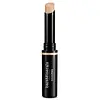What's inside
What's inside
 Key Ingredients
Key Ingredients

 Benefits
Benefits

 Concerns
Concerns

 Ingredients Side-by-side
Ingredients Side-by-side

Hydrogenated Polydecene
EmollientCyclopentasiloxane
EmollientMica
Cosmetic ColorantKaolin
AbrasiveDiphenylsiloxy Phenyl Trimethicone
Skin ConditioningTrimethylsiloxysilicate
EmollientParaffin
PerfumingLithium Magnesium Sodium Silicate
AbsorbentSorbitan Sesquiisostearate
EmulsifyingPolyethylene
AbrasiveGlycerin
HumectantCopernicia Cerifera Wax
CI 77120
Cosmetic ColorantBambusa Arundinacea Stem Extract
Skin ConditioningRosmarinus Officinalis Leaf Extract
AntimicrobialLimonium Gerberi Extract
Skin ProtectingRibes Nigrum Seed Oil
EmollientRubus Idaeus Seed Oil
EmollientHelianthus Annuus Seed Oil
EmollientCaprylic/Capric Triglyceride
MaskingSqualane
EmollientMethicone
EmollientPEG-10 Dimethicone
Skin ConditioningMicrocrystalline Wax
Emulsion StabilisingWater
Skin ConditioningSilica
AbrasiveAlumina
AbrasiveSimethicone
EmollientTocopherol
AntioxidantTocopheryl Acetate
AntioxidantBHT
AntioxidantTitanium Dioxide
Cosmetic ColorantIron Oxides
Hydrogenated Polydecene, Cyclopentasiloxane, Mica, Kaolin, Diphenylsiloxy Phenyl Trimethicone, Trimethylsiloxysilicate, Paraffin, Lithium Magnesium Sodium Silicate, Sorbitan Sesquiisostearate, Polyethylene, Glycerin, Copernicia Cerifera Wax, CI 77120, Bambusa Arundinacea Stem Extract, Rosmarinus Officinalis Leaf Extract, Limonium Gerberi Extract, Ribes Nigrum Seed Oil, Rubus Idaeus Seed Oil, Helianthus Annuus Seed Oil, Caprylic/Capric Triglyceride, Squalane, Methicone, PEG-10 Dimethicone, Microcrystalline Wax, Water, Silica, Alumina, Simethicone, Tocopherol, Tocopheryl Acetate, BHT, Titanium Dioxide, Iron Oxides
Hydrogenated Polydecene
EmollientMica
Cosmetic ColorantOctyldodecanol
EmollientSilica
AbrasivePolyethylene
AbrasiveCaprylic/Capric Triglyceride
MaskingAluminum Starch Octenylsuccinate
AbsorbentCera Microcristallina
Emulsion StabilisingVaccinium Vitis-Idaea Seed Oil
AntioxidantWater
Skin ConditioningPolyhydroxystearic Acid
EmulsifyingPentaerythrityl Tetra-Di-T-Butyl Hydroxyhydrocinnamate
AntioxidantHelianthus Annuus Seed Oil
EmollientRosmarinus Officinalis Leaf Extract
AntimicrobialCI 77007
Cosmetic ColorantUltramarines
CI 77491
Cosmetic ColorantCI 77492
Cosmetic ColorantCI 77499
Cosmetic ColorantCI 77891
Cosmetic ColorantHydrogenated Polydecene, Mica, Octyldodecanol, Silica, Polyethylene, Caprylic/Capric Triglyceride, Aluminum Starch Octenylsuccinate, Cera Microcristallina, Vaccinium Vitis-Idaea Seed Oil, Water, Polyhydroxystearic Acid, Pentaerythrityl Tetra-Di-T-Butyl Hydroxyhydrocinnamate, Helianthus Annuus Seed Oil, Rosmarinus Officinalis Leaf Extract, CI 77007, Ultramarines, CI 77491, CI 77492, CI 77499, CI 77891
Ingredients Explained
These ingredients are found in both products.
Ingredients higher up in an ingredient list are typically present in a larger amount.
This ingredient is an emollient, solvent, and texture enhancer. It is considered a skin-softener by helping the skin prevent moisture loss.
It helps thicken a product's formula and makes it easier to spread by dissolving clumping compounds.
Caprylic Triglyceride is made by combining glycerin with coconut oil, forming a clear liquid.
While there is an assumption Caprylic Triglyceride can clog pores due to it being derived from coconut oil, there is no research supporting this.
Learn more about Caprylic/Capric TriglycerideHelianthus Annuus Seed Oil is the oil derived from the seeds of a Sunflower. Sunflower seed oil is non-fragrant. It is an emollient, meaning it helps to soften the skin.
Sunflower seed oil contains many fatty acids. The fatty acids found in sunflower seeds include (from highest amount to least): linoleic acid, myristic acid, palmitic acid, stearic acid, arachidic acid, oleic acid, and linolenic acid.
These fatty acids help the skin create ceramides. Ceramides play a role in repairing the skin barrier.
Helianthus Annuus Seed Oil helps moisturize the skin. This in turn helps the skin look more rejuvenated and smoother.
Sunflowers are rich in vitamin E.
Historians believe Indigenous cultures of North America domesticated sunflowers before corn. Thus they relied on sunflower oil for a variety of uses. One such use is moisturizing skin and hair.
Sunflower seed oil may not be fungal acne safe. We recommend speaking with a professional if you have any concerns.
Learn more about Helianthus Annuus Seed OilHydrogenated Polydecene is an emollient. It creates a non-occlusive film on the skin that offers extra protection for your skin barrier.
The texture of Hydrogenated Polydecene ranges from light and silky to rich.
Hydrogenated Polydecene is the end compound of controlled hydrogenation of Polydecene.
Learn more about Hydrogenated PolydeceneMica is a naturally occurring mineral used to add shimmer and color in cosmetics. It can also help improve the texture of a product or give it an opaque, white/silver color.
Serecite is the name for very fine but ragged grains of mica.
This ingredient is often coated with metal oxides like titanium dioxide. Trace amounts of heavy metals may be found in mica, but these metals are not harmful in our personal products.
Mica has been used since prehistoric times throughout the world. Ancient Egyptian, Indian, Greek, Roman, Aztec, and Chinese civilizations have used mica.
Learn more about MicaPolyethylene is a synthetic ingredient that helps the skin retain moisture. It is a polymer.
It is also typically used within product formulations to help bind solid ingredients together and thicken oil-based ingredients. When added to balms and emulsions, it helps increase the melting point temperature.
Rosmarinus Officinalis Leaf Extract comes from rosemary. Rosemary is native to the Mediterranean.
While Rosmarinus Officinalis Leaf Oil can be volatile due to its fragrant properties, the fragrance components are usually removed in the leaf extract.
Rosemary Leaf Extract contains many antioxidants such as rosmarinic acid and caffeic acid. Rosemarinic acid, a compound found in rosemary leaf, has been found to help soothe skin conditions such as eczema and acne.
Learn more about Rosmarinus Officinalis Leaf ExtractSilica, also known as silicon dioxide, is a naturally occurring mineral. It is used as a fine, spherical, and porous powder in cosmetics.
Though it has exfoliant properties, the function of silica varies depending on the product.
The unique structure of silica enhances the spreadability and adds smoothness, making it a great texture enhancer.
It is also used as an active carrier, emulsifier, and mattifier due to its ability to absorb excess oil.
In some products, tiny microneedles called spicules are made from silica or hydrolyzed sponge. When you rub them in, they lightly polish away dead skin layers and enhance the penetration of active ingredients.
Learn more about SilicaWater. It's the most common cosmetic ingredient of all. You'll usually see it at the top of ingredient lists, meaning that it makes up the largest part of the product.
So why is it so popular? Water most often acts as a solvent - this means that it helps dissolve other ingredients into the formulation.
You'll also recognize water as that liquid we all need to stay alive. If you see this, drink a glass of water. Stay hydrated!
Learn more about Water